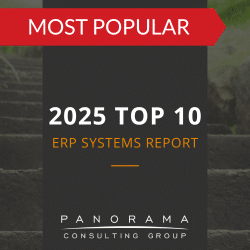- Many ERP project planning failures occur because cross-functional input is missing, leading to misaligned systems that do not meet operational needs.
- Traditional ERP planning often over relies on IT and finance, sidelining key departments like supply chain, manufacturing, and customer service.
- Successful ERP implementations prioritize structured collaboration and translating real-world workflows into actionable ERP requirements from day one.
- Involving cross-functional teams early helps avoid ERP failure, ensuring the selected system supports the entire business.
In a world still reeling from supply chain shocks and workforce disruptions, executive teams are revisiting how they approach digital transformation. And for good reason. ERP project planning remains deeply flawed in how it’s typically approached.
ERP implementation cross-functional collaboration still takes a back seat in most project planning discussions. The result? Delayed timelines, lost ROI, and a cascade of post-launch chaos that executives spend months cleaning up.
We’ve diagnosed hundreds of troubled implementations. Again and again, we find one critical truth: the projects that failed were those where cross-functional collaboration was mostly absent from the planning process.
Let’s explore what’s really going wrong in ERP project planning—and what you can do about it.
Contemplating litigation?
We have multiple software expert witnesses available for provision of reports, depositions, and testimonies.
Why Traditional ERP Planning Misses the Mark
ERP project planning challenges aren’t typically due to poor tools or bad intentions. They stem from how decisions are made. Too often, they’re controlled by a narrow team of IT leaders or finance executives, with minimal input from supply chain, operations, and frontline staff.
This dynamic creates a flawed blueprint—one that prioritizes theoretical functionality over operational reality.
Here are the key pitfalls that arise when cross-functional input is absent:
1. The “One-Size-Fits-All” Blueprint
When ERP planning is isolated to a few departments, the result is a plan that reflects the worldview of those functions.
For example, an IT-centric team might prioritize technical architecture and integrations, while finance might focus on cost control and reporting.
But what about the warehouse team that handles inventory daily? Or the sales team that depends on real-time customer data? Without their perspectives, your blueprint will miss the granular needs that determine whether the system is usable in the real world.
2. Incomplete Requirements
Without structured input from stakeholders across departments, you’re likely to collect requirements that are incomplete or overly generic. This leads to misalignment during vendor demos and software selection, and scope creep during implementation.
In manufacturing companies, our ERP selection consultants conduct interviews and workshops with plant managers, procurement leads, and customer service staff. This early engagement avoids rework down the line.
3. Cultural Resistance and Low Adoption Rates
People support what they help create. If your teams don’t feel involved in the ERP decision, they’re more likely to resist the change. Lack of involvement breeds skepticism, and even passive resistance can derail your adoption goals.
4. Process Silos Amplify Post-Go-Live Problems
ERP systems are designed to unify your processes, but when the planning phase excludes key departments, you’re locking in silos that the system is supposed to eliminate. That’s how companies end up with elegant dashboards that don’t reconcile with real-world workflows, or parallel workflows that duplicate effort and create inefficiencies.
For example, a distribution company might implement a supply chain management system without consulting logistics, fulfillment, and procurement. This could hardwire siloed processes into the new system, forcing teams to maintain separate spreadsheets and manual workarounds.
5. False Confidence in Software Capabilities
Every vendor will tell you their solution supports “end-to-end integration,” but without pressure-testing that claim against actual workflows, you’re gambling.
The top ERP systems may support your industry at a high level, but if you’re not taking the time to understand employee needs, you’re likely to overestimate what the software can do out of the box. That’s a recipe for cost overruns, customization bloat, and, eventually, ERP failures.
What Successful Planning Looks Like
The solution isn’t more meetings or longer RFPs—it’s smarter planning with cross-functional input built in from the very beginning. The most successful ERP transformations are structured like enterprise-wide initiatives, and CEOs should lead with this mindset to set the tone for collaboration, transparency, and accountability.
Here are five cross-functional strategies that can transform your ERP planning:
1. Build a Planning Team
Your ERP planning team should include leaders from manufacturing, finance, customer service, HR, supply chain, and IT. Each brings a different lens to the table—and together, they create a 360-degree view of what your ERP system actually needs to do.
This is your best chance to surface risks, identify dependencies, and align priorities before the project begins.
2. Facilitate Structured Input Sessions
It’s not enough to ask people what they want.
Our ERP selection consultants use guided workshops and role-based process mapping to ensure stakeholders share their needs in a way that’s aligned with how ERP systems actually function. Without this structure, input sessions become laundry lists or turn into airing-of-grievances forums.
A structured approach also ensures your ERP software reflects the unique processes of your industry—not a generic setup built for someone else.
3. Translate Operational Knowledge into ERP Requirements
One of the most overlooked aspects of ERP project planning is translating real-world workflows into actionable system requirements. Your logistics coordinator may not speak “ERP,” but they know exactly what breaks during quarterly surges.
ERP consultants can bridge this gap and play a crucial role in converting process expertise into language vendors can use.
4. Use Cross-Functional Teams to Vet Vendors
Vendor demos should reflect real business scenarios, so it’s important to build demo scripts around cross-functional process flows.
When you include a diverse team in the demo process, you expose weak spots early.
For example, a tool that looks great to IT may fall apart when shown to your procurement lead.
5. Establish Shared Success Metrics
ERP success isn’t measured by going live—it’s about what happens after.
Defining success metrics across teams (i.e., order fulfillment time, invoice accuracy, customer satisfaction) ensures the entire organization is aligned on outcomes. This also gives you an objective framework to evaluate performance over time and identify where retraining or process tweaks might be needed.
Learn More About Project Planning Failure
If ERP project planning is seen as a technical exercise, it will be treated that way—leading to fragmentation, underutilized systems, and rework. But if it’s positioned as a strategic, cross-functional journey, it becomes an opportunity to strengthen collaboration, streamline operations, and drive long-term value.
If you’d like to explore what a truly cross-functional ERP planning process looks like, our independent selection consultants are here to help.














